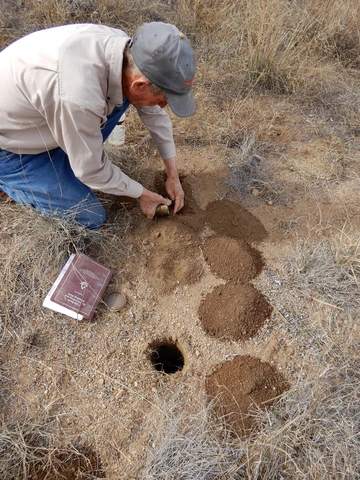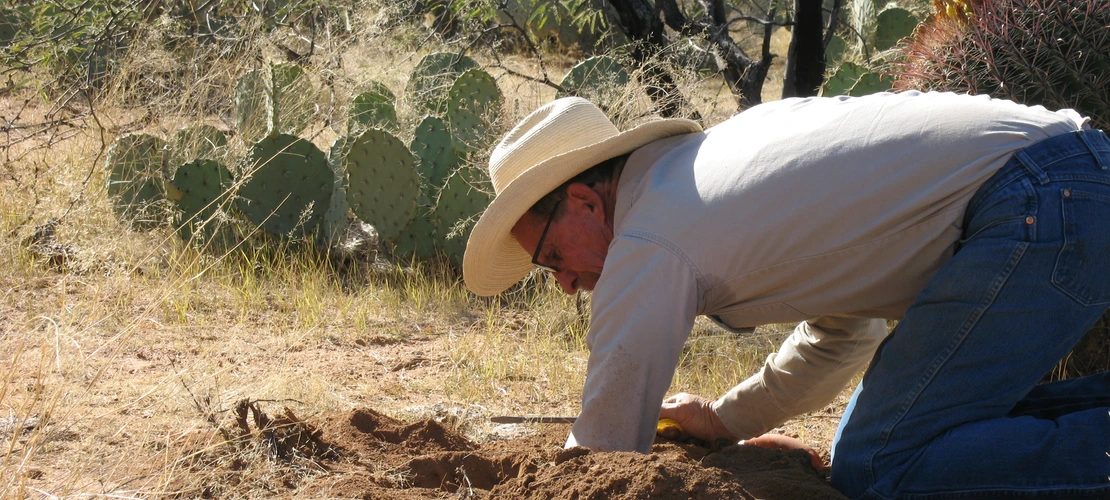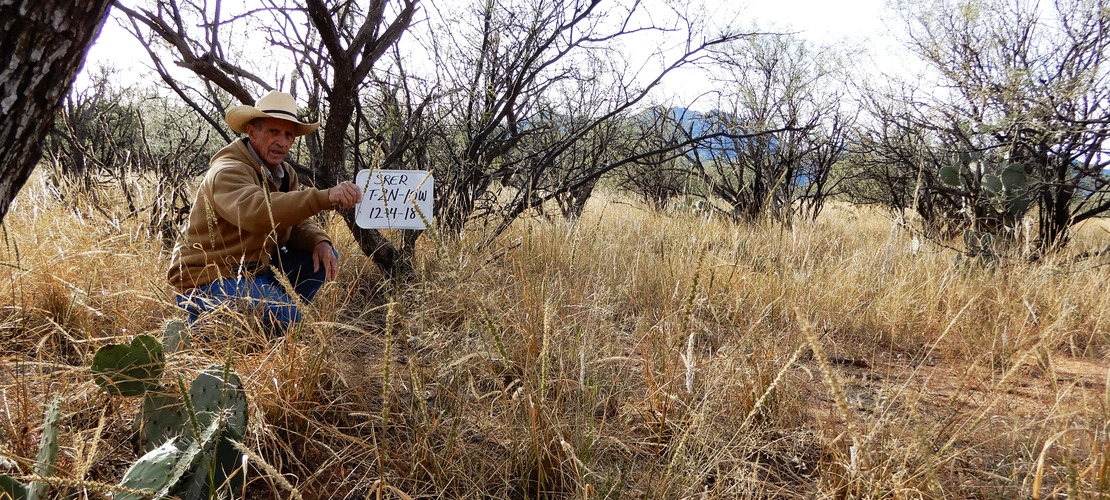
Daniel Robinett sampling soils on the SRER in 2018
The Soil Data and Ecological Sites database provides access to resources and information about the Soils and the Ecological Sites on the Santa Rita Experimental Range (SRER).
The soil survey and rangeland resource inventory of the SRER were conducted in 1997 by the Natural Resources Conservation Service office in Tucson, AZ (Breckenfeld and Robinett 2003). Thirty-two soil series and taxadjuncts are found on the SRER and delineated in 24 different mapping units. These soils all occur in an Aridic and Ustic moisture regime and span three precipitation zones, and all soils are in the thermic soil temperature regime. Eighteen Ecological Sites are found in two Major Land Resource Areas (MLRA 40 and 41): eight ecological sites in the 10- to 13-inch precipitation zone of MLRA 40, the Upper Sonoran Desert; eight sites in the 12- to 16-inch precipitation zone of MLRA 41, the Southern Arizona Grassland; two sites in the 16- to 20-inch precipitation zone of MLRA 41, the Mexican Oak Savanah".
A copy of this study as well as other data and references about Soils and Ecological Sites on the SRER are provided in the sections below.
References
Breckenfeld, Donald J.; Robinett, Daniel. 2003. Soil and Ecological Sites of the Santa Rita Experimental Range. In: McClaran, Mitchel P.; Ffolliott, Peter F.; Edminster, Carleton B., tech. coords. Santa Rita Experimental Range: 100 years (1903 to 2003) of accomplishments and contributions; conference proceedings; 2003 October 30–November 1; Tucson, AZ. Proc. RMRS-P-30. Ogden, UT: U.S. Department of Agriculture, Forest Service, Rocky Mountain Research Station. p. 157-165.
The soils of the SRER have been deeply studied over the years and described in several publications. Most comprehensive references include soil inventories; others analyze specific characteristics of soils and relate them to vegetation or other environmental features.
All available references to historic and recent studies about soils can be found in:
- the 1996 Medina's publication Santa Rita Experimental Range: History and Annotated Bibliography (1903-1988)
- the proceedings of the 2003 centennial conference Santa Rita Experimental Range: 100 years (1903 to 2003) of accomplishments and contributions
- the list of most recent Publications on the SRER (1951 to present).
Vector data to be used in Geographic Information System software and related metadata files about the 1996 NRCS Soil Surveys are also available for download on Spatial Data.
Soil inventories and descriptions are provided by the following publications:
- Appendix A of 1996 Medina's publication Santa Rita Experimental Range: History and Annotated Bibliography (1903-1988), which lists the soils known from the SRER until 1988
- Special Report Soil and Range Resource Inventory of the Santa Rita Experimental Range (Breckenfeld and Robinett 1997)
- Proceeding papers Soil and Ecological Sites of the Santa Rita Experimental Range (Breckenfeld and Robinett 2003) and Spectral Reflectance and Soil Morphology Characteristics of Santa Rita Experimental Range Soils (Batchily et al. 2003), included in the centennial conference proceedings "Santa Rita Experimental Range: 100 years (1903 to 2003) of accomplishments and contributions"
Ecological Sites are used to organize information about rangeland plant species abundance and productivity, as well as expectations about the response to management and weather conditions. Criteria for distinguishing Ecological Sites include soil traits, geomorphic position on the landscape, and climate variables. More information about ecological sites is available in Brown, J.R. 2010. Ecological sites: their history, status, and future. Rangelands 32(6):5-8.
The USDA Natural Resources Conservation Service (NRCS) developed and manages the Ecological Site Descriptions Information System (ESIS), accessible via the USDA website. The ESIS is the repository for the data associated with the collection of forestland and rangeland plot data and the development of ecological site descriptions (ESD). The Ecosystem Dynamics interpretative Tool (EDIT) is maintained by the USDA-ARS Jornada Experimental Range. It is an online information system for the development and sharing of ecological site descriptions, ecosystem state and transition models, and land management knowledge.
The Ecological Sites on the SRER are deeply described in the two main publications available below for download. On this website, it is also possible to access the Ecological Site Designation for the Ongoing Vegetation Transects and for the Exclosure Transects performed at the SRER.
- Special Report Soil and Range Resource Inventory of the Santa Rita Experimental Range(Breckenfeld and Robinett1997)
- Proceeding paper Soil and Ecological Sites of the Santa Rita Experimental Range (Breckenfeld and Robinett 2003), included in the centennial conference proceedings "Santa Rita Experimental Range: 100 years (1903 to 2003) of accomplishments and contributions"



